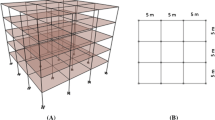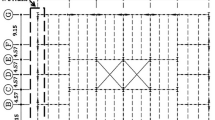Abstract
The collapse capacity of a structure employing hysteretic energy dissipating devices (HEDDs) is considerably influenced by the uncertainties which are categorized to the aleatory and epistemic uncertainties. This study aims to comparatively evaluate uncertainty-propagations to the seismic collapse performance of the low-rise steel moment-resisting frames (SMRFs) with and without HEDDs, and to investigate on the effects of HEDDs to the failure modes of damped structures when the uncertainties are collectively propagated to the seismic response. In order to achieve this, incremental dynamic analyses are carried out to assess the collapse capacities of typical low-rise SMRFs with and without HEDDs. The Monte-Carlo simulation adopting a Latin hypercube sampling method is then performed to reflect the probabilistic uncertainty-propagation to the collapse capacities of structures. The analysis results show that the collapse capacities of low-rise SMRFs are considerably changed due to the uncertainty-propagation and HEDDs decrease the uncertainty-propagation to the collapse capacities of low-rise SMRFs because they induces a constant collapse mode with relatively low variation.
Similar content being viewed by others

References
AISC. Prequalified connections for special and intermediate steel moment frames for seismic applications including supplement No. 1, ANSI/AISC 358-05, American Institute of Steel Connection, Inc., Chicago, IL, USA, 2010.
ASCE/SEI 7, (2005). Minimum design loads for buildings and other structures, American Society of Civil Engineers, Virginia, USA.
ASCE/SEI 7, (2010). Minimum design loads for buildings and other structures, American Society of Civil Engineers, Virginia, USA.
Carr A. J. User’s manual of RUAUMOKO, the Maori god of Volcanoes and earthquakes, Department of Civil Engineering, University of Canterbury, New Zealand, 2009.
Christopoulos, C. and Filiatrault, A. Principles of passive supplemental damping and seismic isolation, 2007, IUSS Press, Pavia, Italy.
Constantinou, M. C., Soong, T. T. and Dargush, G. F. Passive Energy Dissipation Systems for Structural Design and Retrofit, MCEER Monograph No. 1, Multidisciplinary Center for Earthquake Engineering Research, University at Buffalo, Buffalo, New York, USA, 1998.
Dolsek, M. Incremental dynamic analysis with consideration of modeling uncertainties, Earthquake Engineering and Structural Dynamics, 2009, 38, pp. 805–825.
Ellingwood, B., Galambos, T. V. and MacGregor, J. G. Development of a Probability-based Load Criterion for American National Standard A58, Washington, D.C., USA, 1980.
FEMA, NEHRP Recommended Provisions for Seismic Regulations for New Buildings and Other Structures, FEMA 450, Washington D.C., USA, 2003.
FEMA, Next-Generation Performance-Based Seismic Design Guidelines: Program Plan for New and Existing Buildings, FEMA 445, Washington D.C., USA, 2006.
FEMA. Pre-standard and commentary for the seismic rehabilitation of buildings, FEMA 356, Federal Emergency Management Agency, Washington D.C., USA, 2000.
FEMA. Quantification of building seismic performance factors, FEMA P695, Federal Emergency Management Agency, Washington D.C., USA, 2009.
Fragiadakis, M. and Vamvasikos, D. Fast Performance Uncertainty Estimation via Pushover and Approximate IDA, Earthquake Engineering and Structural Dynamics, 2010, 39, pp. 683–703.
Grant, L. H., Mirza, S. A. and MacGregor, J. D. Monte Carlo Study of Strength of Concrete Columns, ACI Journal, 1978, 75(8), pp. 348–358.
Iman, R. Latin Hypercube Sampling, Encyclopedia of Statistical Sciences, Wiley, New York, USA, 1999.
Jalayer, F. and Beck, J. L. Effects of two alternative representations of ground-motion uncertainty on probabilistic seismic demand assessment of structures, Earthquake Engineering and Structural Dynamics, 2008, 37, pp. 61–79.
Jalayer, F., Ieryolino, I. and Manfredi, G. Structural modeling uncertainties and their influence on seismic assessment of existing RC structures, Structural Safety, 2010, 32, pp. 220–228.
Kazanzi, A. K., Righiniotis, T. D. and Chryssanthpoulos, M. K. Fragility and hazard analysis of a welded steel moment resisting frame, Journal of Earthquake Engineering, 2008, 12(4), pp. 596–615.
Lee, T. H. and Mosalam, K. M. Seismic demand sensitivity of reinforced concrete shear-wall building using FOSM method, Earthquake Engineering and Structural Dynamics, 2005, 34, pp. 1719–1736.
Liel, A, B., Haselton, C. B., Deierlein, G. G. and Baker, J. W. Incorporating modeling uncertainties in the assessment of seismic collapse risk of buildings, Structural Safety, 2009, 31, pp. 197–211.
McKay, M., Conover, W. and Beckman, R. A Comparison of Three Methods for Selecting Values of Input Variables in the Analysis of Output from a Computer Code, Technometrics, 1979, 21(2), pp. 239–245.
Melhchers, R. E. Structural Reliability Analysis and Prediction, Wiley, New York, USA, 1999.
Otani, S. Hysteresis model of reinforced concrete for earthquake response analysis, Journal of Faculty of Engineering, University of Tokyo, Tokyo, 1981, 36(2), pp. 125–159.
Porter, K. A., Beck, J. L. and Shaikhutdinov, R. V. Sensitivity of Building Loss Estimates to Major Uncertain Variables, Earthquake Spectra, 2002, 18(4), pp. 719–743.
Ramirez, O. M., Constantinou, M. C., Kircher, C. A., Whittaker, A. S., Johnson, M. W., Gomez, J. D., and Chrysostomou, C. Z. Development and evaluation of simplified procedures for analysis and design of buildings with passive energy dissipation systems, Report No. MCEER 00-0010, Revision 1, Multidisciplinary Center for Earthquake Engineering Research, University at Buffalo, State University of New York, Buffalo, N.Y., USA, 2000.
Reed, J. W. and Kennedy, R. P. Methodology for Assessment of Nuclear Power Plant Seismic Margin, Rev. 1, EPRI NP-6041-SL, Electric Power Research Institute, California, USA, 1991.
Rosenblueth, E. A Basis for a Seismic Design, Ph.D thesis, University of Illinois Urbana, I11, 1951.
Shome, N. and Cornell, C. A. Probabilistic seismic demand analysis of nonlinear structures, Report No. RMS-35, RMS Program, Stanford University, Stanford, CA, 1999.
Soong, T.T. and Dargush, G.F. Passive Dissipation Systems in Structural Engineering, John Wiley & Sons, Inc., New York, USA., 1997.
Tagawa, H., MacRae, G. and Lowes, L. Probabilistic evaluation of seismic performance of 3-story 3D one-and two-way steel moment-frame structures, Earthquake Engineering and Structural Dynamics, 2008, 37, pp. 681–696.
Tsai, K.C., Cheng, H.W., Hong, C.P., and Su, Y. F. Design of steel triangular plate energy absorbers for seismicresistant construction, Earthquake Spectra, 1993, 9(3), pp. 505–528.
Vamvatsikos, D. and Fragiadakis, M. Incremental dynamic analysis for estimating seismic performance sensitivity and uncertainty, Earthquake Engineering and Structural Dynamics, 2009, 39(2), pp. 141–163.
Vamvatsikos, D., and Cornell, C. A. Incremental Dynamic Analysis, Earthquake Engineering and Structural Dynamics, 2002, 31(3), pp. 491–514.
Yin, Y. J. and Li, Y. Seismic collapse risk of light-frame wood construction considering aleatory and epistemic uncertainties, Structural Safety, 2010, 32(4), pp. 250–261.
Author information
Authors and Affiliations
Corresponding author
Rights and permissions
About this article
Cite this article
Shin, DH., Yang, WJ. & Kim, HJ. Comparative evaluation of probabilistic uncertainty-propagations to seismic collapse capacity of low-rise steel moment-resisting frames. Int J Steel Struct 16, 887–900 (2016). https://doi.org/10.1007/s13296-016-0066-z
Received:
Accepted:
Published:
Issue Date:
DOI: https://doi.org/10.1007/s13296-016-0066-z



